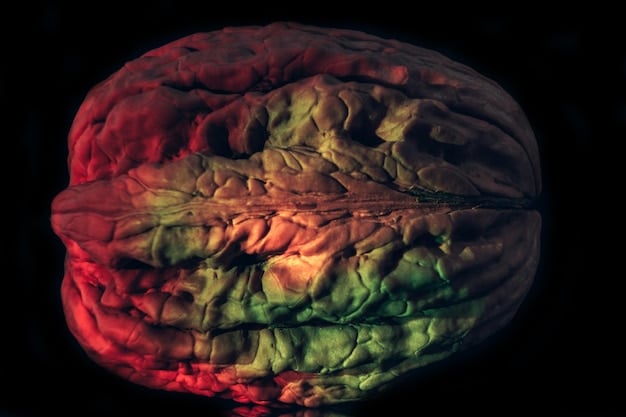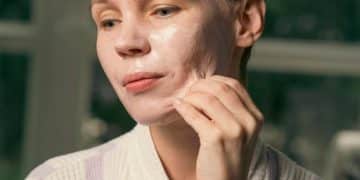The Updated Guide to Managing Seasonal Affective Disorder (SAD) This Winter

Seasonal Affective Disorder (SAD) is a type of depression that occurs during specific seasons, typically winter, due to reduced sunlight exposure, but understanding its symptoms, causes, and effective management strategies can help mitigate its impact and improve overall well-being.
Winter can be a beautiful time of year, but for many, it brings the unwelcome guest of Seasonal Affective Disorder (SAD). Our updated guide to managing Seasonal Affective Disorder (SAD) during the winter months offers practical strategies to help you navigate the challenges and find joy throughout the season.
Understanding Seasonal Affective Disorder (SAD)
Seasonal Affective Disorder (SAD) is more than just the “winter blues.” It’s a recognized form of depression linked to the changing seasons, typically starting in the fall and continuing through the winter months. Understanding what SAD is, its symptoms, and what causes it is the first step to managing it effectively.
What is SAD?
SAD is a type of depression that follows a seasonal pattern. It’s characterized by recurring depressive episodes that coincide with specific times of the year, most often the winter. As the days get shorter and sunlight decreases, people with SAD experience changes in mood, energy levels, and overall well-being.
Common Symptoms of SAD
The symptoms of SAD can vary from person to person but often include:
- Persistent low mood or sadness
- Loss of interest or pleasure in activities
- Changes in appetite or weight (often craving carbohydrates)
- Sleep problems (usually oversleeping)
- Fatigue and low energy
- Difficulty concentrating
- Feelings of hopelessness, worthlessness, or guilt
What Causes SAD?
The exact cause of SAD isn’t fully understood, but several factors are believed to play a role:
- Reduced sunlight exposure: Lower sunlight levels can disrupt the body’s internal clock (circadian rhythm), leading to mood disturbances.
- Changes in melatonin levels: Sunlight helps regulate the production of melatonin, a hormone that affects sleep and mood. In winter, increased melatonin levels can cause fatigue and depression.
- Serotonin imbalance: Sunlight also affects serotonin, a neurotransmitter that helps regulate mood. Reduced sunlight can lead to decreased serotonin levels, contributing to depression.

Understanding these symptoms and potential causes can help individuals recognize if they might be experiencing SAD. Early recognition is crucial for seeking appropriate treatment and implementing effective lifestyle changes.
Light Therapy: A Bright Idea for SAD
Light therapy is a cornerstone treatment for Seasonal Affective Disorder (SAD). It involves exposure to a bright light that mimics natural sunlight, helping to regulate the body’s internal clock and improve mood. This section explores the benefits of light therapy, how to use a light box effectively, and other considerations.
The Benefits of Light Therapy
Light therapy can provide several benefits for individuals with SAD, including:
- Improved mood and energy levels
- Regulation of sleep patterns
- Reduction in depressive symptoms
- Increased alertness and focus
How to Use a Light Box
Using a light box correctly is essential for maximizing its effectiveness:
- Choose the right light box: Look for a light box that emits 10,000 lux and filters out harmful UV rays.
- Position the light box correctly: Place the light box about 12-24 inches away from your face, angled slightly to the side. Don’t look directly at the light.
- Time your sessions: Most people find that 20-30 minutes of light therapy in the morning is most effective.
- Be consistent: Use the light box daily, especially during the fall and winter months, to maintain its benefits.
It’s essential to follow the manufacturer’s instructions and consult with a healthcare professional before starting light therapy to ensure it’s appropriate for your specific needs.
Other Considerations for Light Therapy
While light therapy is generally safe, there are a few considerations to keep in mind:
- Side effects: Some people may experience mild side effects such as headaches, eye strain, or nausea. These are usually temporary and can be reduced by adjusting the intensity or duration of the sessions.
- Medical conditions: Light therapy may not be suitable for individuals with certain medical conditions, such as bipolar disorder or eye disorders.
- Combination with other treatments: Light therapy can be used in combination with other treatments, such as medication or psychotherapy, for more comprehensive management of SAD.
By understanding the benefits, proper usage, and considerations of light therapy, individuals with SAD can use it as an effective tool to brighten their winter months.
Lifestyle Adjustments to Combat SAD
In addition to light therapy, making certain lifestyle adjustments can significantly help in managing Seasonal Affective Disorder (SAD). These changes focus on enhancing overall well-being, boosting mood, and increasing energy levels. Here are some key lifestyle adjustments to consider:
Regular Exercise
Engaging in regular physical activity can have a profound impact on mental health. Exercise stimulates the release of endorphins, which are natural mood boosters. Aim for at least 30 minutes of moderate-intensity exercise most days of the week.
Activities such as:
- Walking or jogging outdoors
- Yoga or Pilates
- Swimming
These can be particularly effective in combating SAD symptoms. Exercising outdoors during daylight hours can also help increase exposure to natural light, further enhancing mood.
Diet and Nutrition
A balanced diet plays a crucial role in maintaining overall health and well-being. During the winter months, it’s essential to focus on nutrient-rich foods that support mood and energy levels.
- Consume plenty of fruits and vegetables
- Include sources of omega-3 fatty acids, such as fish and flaxseeds
- Limit processed foods, sugar, and caffeine
Additionally, consider Vitamin D supplementation, as low Vitamin D levels have been linked to depressive symptoms, especially during the winter months.
Mindfulness and Stress Reduction
Stress can exacerbate SAD symptoms, so incorporating mindfulness and stress-reduction techniques into your daily routine can be beneficial.
- Practice meditation or deep breathing exercises
- Engage in hobbies and activities you enjoy
- Spend time in nature
Mindfulness practices can help you stay present and reduce feelings of anxiety and overwhelm, promoting a sense of calm and well-being during the challenging winter months.

By integrating these lifestyle adjustments into your daily routine, you can proactively manage SAD symptoms and improve your overall quality of life during the winter months.
The Role of Therapy and Counseling
Therapy and counseling can be highly effective components of a comprehensive treatment plan for Seasonal Affective Disorder (SAD). These approaches provide individuals with tools and strategies to manage their symptoms, improve their coping skills, and enhance their overall well-being. Engaging with a mental health professional can make a significant difference in navigating the challenges of SAD.
Cognitive Behavioral Therapy (CBT)
CBT is a type of therapy that focuses on identifying and changing negative thought patterns and behaviors that contribute to depression. For individuals with SAD, CBT can help them recognize and challenge negative beliefs and attitudes associated with the winter months.
Key aspects of CBT for SAD include:
- Identifying negative thought patterns
- Challenging and reframing these thoughts
- Developing coping strategies to manage stressful situations
By learning to modify their thoughts and behaviors, individuals can reduce the impact of SAD symptoms on their daily lives.
Interpersonal Therapy (IPT)
IPT focuses on improving interpersonal relationships and addressing social factors that may contribute to depression. For individuals with SAD, IPT can help them enhance their social support network and develop healthier communication skills.
Key goals of IPT for SAD include:
- Identifying and addressing relationship issues
- Improving communication skills
- Building a stronger social support network
By strengthening their relationships and social connections, individuals can combat feelings of isolation and loneliness often associated with SAD.
When to Seek Professional Help
It’s essential to seek professional help if SAD symptoms are severe or significantly impacting your daily life. Signs that it’s time to consult a mental health professional include:
- Persistent feelings of sadness or hopelessness
- Loss of interest in activities
- Significant changes in appetite or sleep
- Difficulty concentrating or making decisions
Engaging in therapy or counseling can provide you with the support and tools you need to effectively manage SAD and improve your overall mental health.
Seeking therapy and counseling can offer valuable support and coping mechanisms for individuals struggling with SAD. These therapeutic approaches empower individuals to manage their symptoms, improve their relationships, and enhance their overall quality of life.
Medication Options for SAD
In some cases, medication may be a necessary part of managing Seasonal Affective Disorder (SAD). Antidepressants can help regulate mood and alleviate symptoms when lifestyle adjustments and light therapy are not sufficient. This section explores the types of medications commonly prescribed for SAD and important considerations regarding their use.
Selective Serotonin Reuptake Inhibitors (SSRIs)
SSRIs are a class of antidepressants that increase the levels of serotonin in the brain. Serotonin is a neurotransmitter that plays a crucial role in regulating mood, and SSRIs can help alleviate depressive symptoms by enhancing its availability. Common SSRIs prescribed for SAD include:
- Sertraline (Zoloft)
- Paroxetine (Paxil)
- Fluoxetine (Prozac)
SSRIs are often the first-line medication choice for SAD due to their effectiveness and relatively mild side effects.
Other Antidepressants
In addition to SSRIs, other types of antidepressants may be prescribed for SAD, depending on individual needs and responses. These include:
- Serotonin-Norepinephrine Reuptake Inhibitors (SNRIs): SNRIs, such as venlafaxine (Effexor), increase both serotonin and norepinephrine levels in the brain.
- Bupropion (Wellbutrin): Bupropion is a norepinephrine-dopamine reuptake inhibitor (NDRI) that can help improve energy levels and motivation.
The choice of antidepressant depends on various factors, including specific symptoms, potential side effects, and individual medical history.
Important Considerations
Before starting medication for SAD, it’s crucial to consult with a healthcare professional. Important considerations include:
- Discussing medical history and any existing health conditions
- Understanding potential side effects and interactions with other medications
- Following the prescribed dosage and timing
It’s also essential to be patient, as it may take several weeks for antidepressants to take full effect. Regular follow-up appointments with the healthcare provider are necessary to monitor progress and adjust the treatment plan as needed.
While medication can be an effective tool in managing SAD, it’s essential to work closely with a healthcare professional to determine the most appropriate treatment plan. Antidepressants can help alleviate symptoms and improve overall well-being when used correctly and in conjunction with other therapeutic approaches.
Creating a Supportive Environment
Creating a supportive environment is crucial for managing Seasonal Affective Disorder (SAD) effectively. This involves surrounding yourself with positive influences, fostering connections with others, and implementing self-care strategies that promote well-being. A supportive environment can significantly enhance your ability to cope with the challenges of SAD and improve your overall quality of life.
Building a Strong Support Network
Having a strong support network is essential for managing SAD. This involves connecting with friends, family, and support groups who can provide emotional support and understanding.
Strategies for building a support network include:
- Reaching out to friends and family
- Joining a support group for individuals with SAD
- Participating in social activities
Sharing your experiences and feelings with others can help you feel less alone and more supported during the winter months.
Creating a Comfortable Home Environment
Your home environment can significantly impact your mood and energy levels. Creating a comfortable and inviting space can help alleviate SAD symptoms.
Tips for creating a comfortable home environment include:
- Maximizing natural light by keeping windows clean and open
- Using bright, warm-toned lighting
- Adding plants and natural elements to your décor
Creating a space that feels cozy and inviting can promote relaxation and improve your overall mood.
Prioritizing Self-Care
Self-care is essential for managing SAD. This involves engaging in activities that promote your physical, emotional, and mental well-being.
- Getting enough sleep
- Eating a balanced diet
- Engaging in activities you enjoy
By prioritizing self-care, you can reduce stress, boost your mood, and improve your ability to cope with SAD symptoms.
| Key Point | Brief Description |
|---|---|
| ☀️ Light Therapy | Use a 10,000 lux light box for 20-30 minutes each morning to simulate sunlight. |
| 🏃 Regular Exercise | Aim for 30 minutes of moderate exercise most days to boost endorphins. |
| 🍎 Balanced Diet | Focus on fruits, vegetables, and Omega-3s; consider a Vitamin D supplement. |
| 🧘 Mindfulness | Practice meditation and stress-reduction techniques to manage anxiety. |
Frequently Asked Questions (FAQ)
▼
Seasonal Affective Disorder (SAD) is a type of depression related to changes in seasons, most common during winter due to reduced sunlight. It affects mood, energy, and sleep patterns.
▼
Light therapy uses a bright light box to mimic natural sunlight, helping regulate the body’s sleep-wake cycle and boost serotonin levels, thus improving mood and energy.
▼
Regular exercise, a balanced diet, and mindfulness practices can help manage SAD. Physical activity boosts endorphins, while a good diet supports mood and energy levels.
▼
Seek help if your symptoms are severe or disrupt daily life. Persistent sadness, loss of interest, or changes in appetite/sleep warrant professional consultation and treatment.
▼
Yes, antidepressants such as SSRIs can help regulate mood and alleviate severe SAD symptoms. Consult a healthcare provider to discuss medication options and potential side effects.
Conclusion
Managing Seasonal Affective Disorder (SAD) during the winter months requires a multi-faceted approach that includes light therapy, lifestyle adjustments, and, in some cases, professional help. By understanding SAD, implementing effective strategies, and creating a supportive environment, you can navigate the winter blues and maintain your well-being.





